TWILIGHT OF THE PISTONS | Click here to buy the book or look at our other publications about the history of The Isle of Thanet
TWILIGHT OF THE PISTONS | Chapter 2
Chapter 2
CHAPTER 2
STARTING UP
The man who opened up Manston for civil operations in April 1959 was Wing Commander H.C. Kennard. He was involved, at one time or another, with virtually all of the famous Kent airfields and his exploits through the years are worthy of a book of their own.
He learnt to fly at Prestwick in 1937 and by the following year was a Pilot Officer on No. 66 Squadron when they were the second R.A.F. unit, after No. 19 their sister squadron at Duxford, to receive Spitfires. During the evacuation of Dunkirk, in May 1940, Hugh flew covering patrols; this operation, and the French campaign it ended, inflicting very serious losses on Fighter Command. No. 66 Squadron was at Coltishall, as part of 12 Group, during the Battle of Britain and Hugh fought in this historic struggle over the southern counties. At the end of August he was posted, as a flight commander, to assist in forming No. 306, a Polish squadron with Hurricanes, this unit becoming operational towards the end of the battle.
Hugh's organisational abilities must have been notable because, in May 1941 he was transferred again, this time to help form No. 121 Squadron, one of the three famous American `Eagle' squadrons that flew in the R.A.F. In early 1942 Hugh took command of No. 121 and, that summer, led them on offensive sweeps over occupied France. He shot down several German aircraft, and on one very eventful sortie, following an attack by three FW190s, he was injured. Just making the coast, he crash landed in a potato field close to where Lydd Airport was later constructed.
Hugh was taken to hospital and put to bed; whereupon a doctor said that the injuries to his arm made an operation necessary. As one who did not like the clinical atmosphere, Hugh replied that he was not going to have this treatment. The situation was neatly resolved by the American pilots of No. 121, who held Squadron Leader Kennard in some regard, by `kidnapping' their commanding officer and staging a tactical withdrawal back to their airfield in Essex.
In September, Hugh left the squadron which was handed over to the U.S.A.A.F. and became part of the 4th. Fighter Group of the Eighth Air Force. Hugh received a DFC and was taken off operations; in May 1945 he returned to fighters when he was given command of one of the famous units, 74 Squadron.
By September 1945 Hugh had been appointed Commanding Officer of R.A.F. Hawkinge and it was while he was there that he received a signal notifying him of an impending posting to Malaya. Not wishing at that stage to go east, the Wing Commander flew his personal Hawker Tempest to see the Commander in Chief of Fighter Command, Sir Sholto Douglas. As a result of this meeting Hugh Kennard left the R.A.F. three days later and immediately turned his attention to the field of civil aviation.
Following its active role during the war Lympne was also reverting to civilian use and Hugh Kennard acquired a single hut from the large selection available, invested some of his gratuity in a brand new Miles Messenger, and began to look for business.
In the early postwar years it was often necessary to fly to Croydon Airport to seek charter work. Against a European backcloth of destruction and massive shortages the credentials of some of those chartering light aircraft to go there were sometimes less than impeccable. Flying aircraft such as the Messenger, Hawk and Consul and assisted by his wife Audry, who ran the Traffic side of the business, Hugh Kennard built up his company, Air Kruise. Audry's father farmed at Alkham and at one time owned his own aircraft. As a pilot he became friendly with Hugh, who was also from a farming background, and from this acquaintance Hugh and Audry first met. As more work came in for Air Kruise, they acquired some Dragon Rapides and started to carry passengers whose journeys, and stay abroad, had been organised as a package; the beginning of Inclusive Tours.
As mentioned earlier, Silver City was also developing their business at Lympne, the well known pre-war airfield once again well in the limelight.
As a member of the Royal Auxiliary Air Force, Hugh Kennard kept closely in touch with military flying and on one occasion flew a Meteor F3 into Lympne, an event which must have caused some heads to turn on the grass airfield and from which the local aircraft spotters have probably never recovered.
Hugh Kennnard's fertile mind was receptive to many entrepreneurial opportunities; he had taken a twenty one year lease on Ramsgate Airport, often referred to locally as `Pysons Road'. This was a typical pre-war municipal airport built when any town worth its salt wanted to be part of the developing aviation scene. Ramsgate Airport would feature again and again in the following years of Hugh's life. In 1953 he advertised for a flying instructor to act as manager and, after a meeting, Ron Pullinger was appointed. For Eileen Pullinger this was the beginning of a close acquaintance with Hugh Kennard that would last over forty years.
The operation at Ramsgate was by Air Kruise at this time and a two-tone painted hangar adjoined the control/administration block which had been completely refurbished. As C.F.I., Ron looked after the training although other work for the Austers, Messenger and other light aircraft of the day was pleasure flying and some aerial photography.
Needing some help from a photographic shop in Hythe one time, Hugh became very involved in a discussion which resulted in the formation of Sky Photos at Lympne, an aerial photographic company which used light aircraft such as the Auster and was a familiar part of the Kent scene for many years. Flying back from some chore one day along the south coast they passed above a ferry heading for Dover; Hugh bade the reluctant photographer to take a few shots and they sold the result as framed pictures for the cabins and company offices and as a print for postcards to sell to passengers using the ferries.
Silver City and Air Kruise worked closely together at Lympne, Silver City carrying out a number of services, including engineering, for the Kennards' company. This collaboration eventually resulted in Silver City taking over Air Kruise and Hugh Kennard became the joint managing director of the enlarged company. Air Kruise aorcraft continued to operate under that name, the faithful Rapides being replaced by DC-3s.
By this time Silver City had taken the brave decision to build their own airport at Lydd and the companies moved there in 1954; Air Kruise finally lost its separate identity four years later. When an opportunity arose Hugh was still quick to see the potential; there was a need for the gearboxes of the hard worked Bristols and the Hermes to be overhauled and this led him to form a company called Aircraft Engineering and Maintenance at Ramsgate Airport to carry out the work.
Eileen joined Ron at Pysons Road and looked after the books of A.E.M. although her duties at the airport were somewhat broad, being involved in most of the activities such as charging landing fees and bar stocktaking. One day Hugh said to her: `You had better take a first aid course,' and this was nearly needed in earnest later on when a pilot landed a light aircraft upside down in a tree on the edge of the airport. Eileen trotted over with her little case to be greeted by the inverted aviator calling down: `By jove am I glad to see you.'
Although sometimes a stern looking figure, Hugh was a considerate employer and on one occasion lent his Messenger to Ron and Eileen to take two friends over to Paris. There was a friendly club atmosphere at Pysons Road and occasionally a small group would stay around the bar without too much heed as to how quickly time was passing. One night the jealous landlord of the pub up the road tipped off the police who raided the airport and interviewed all concerned, except the company solicitor who had baled out through a convenient window, as to what they had been drinking.
A court case followed and Hugh asked Eileen: `Are you going to be alright?' They were not sure, so Hugh arranged for a Q.C. to represent the airport, successfully, as the case was eventually thrown out. In their zeal the police had entered five minutes the wrong side of midnight and their contention that the brown liquid they had seen poured, while they were looking in through a window, was alcoholic was contested as being Coca Cola!
One of the many enthusiasts who flew from Ramsgate Airport at this time was Brian McAvoy, a general practitioner and a friend of Hugh's.
Later on, after a spell flying oil prospectors round North Africa, Ron Pullinger joined Silver City flying the Wayfarers and the pleasure flying at Ramsgate was let out as a concession.
Once the Silver Arrow service was established, Hugh spent some time away from Manston, usually in London seeking new business. The Kennards lived at Linton, near Maidstone, and it was common practice when he was away for Audry to make a daily round trip, driving Linton-Lydd-Manston-Linton to keep everything running, in addition to a days work at Manston. On one occasion there had also been a visit over to the Paris Air Show and back, on top of this tiring routine and, next day, Audry went to sleep while driving near Rye and collided with a tree.
After some eighteen months at Manston, Hugh resigned from Silver City in November 1960. The break was mostly due to the differing personalities of Hugh and Eion Mekie, the chairman of Silver City. Hugh was probably keen to follow through some of his entrepreneurial ideas while the remainder of the Silver City management were becoming somewhat beleaguered through continuing unprofitability, compared with Channel Air Bridge.
There was an eighteen months restraint of trade clause in his contract so he moved to Ramsgate Airport to lay plans for the day that he could re-enter the airline business. The clause was almost mathematically adhered to as Air Ferry began to take physical shape at Manston in the summer of 1962. While at Pysons Road they built up Aviation Engineering and Maintenance as, for a time, the Kennards' income had to come from this company.
Hugh felt some rancour against his former colleagues who called themselves `The Air Ferry', operated from an airport called `Ferryfield' and used the telex callsign `Air Ferry'. Airline names beginning with `Air' have always been popular but the decision by Hugh Kennard to call his new airline `Air Ferry' was bound to be provocative and seen as a way to get back at Silver City.
The actual registration that notified the business world of the new company's name must have occurred about May or June 1961 and it was not long before Freddie Laker, Managing Director of B.U.A., was on the telephone to Ramsgate Airport. It seems unlikely that the registration alone of a new company was a material enough threat to the B.U.A. group for it to be seriously concerned. It is perhaps more likely, given the fiercely independent record of the two individuals concerned, that there was a touch of pique due to Hugh Kennard's previous success.
Freddie Laker said: `You can't do this,' whereupon Hugh Kennard said that he had and a lively debate ensued. It was obvious that Laker was determined to obtain the name and he made an offer to acquire it. The figure mentioned was substantial and it is interesting to consider what the effect upon the future course of events would have been had the offer been accepted. It is almost certain that the suggestion was placed before the B.U.A. board but, for whatever reason, Hugh Kennard heard no more of the matter.
.At this time the B.U.A. drive to lead the independents was in full flood and it is possible discussions had commenced with P. & O. for the takeover of British Air Services, which included Silver City. According to Douglas Whybrow's book, the Chairman of P. & O. and Sir Miles Wyatt reached the agreement some months later for the sale of P. & O.'s 51% holding, without Laker being consulted. Following this upheaval most of the remaining Silver City directors resigned.
Within a few months of this change the Silver City operation at Manston ended. Freddie Laker came down to give the staff a `pep' talk in the hangar which resulted in a few of the engineers being offered jobs at B.U.A. The Hermes went to Gatwick, the remainder of the staff were made redundant and the civilian side of the airfield closed until Air Ferry opened some months later.
Another telephone call received when Hugh Kennard was in his `bolt hole' at Ramsgate Airport was from a previous First Officer on the Hermes, Adam Thomson. He said he was planning to start operations with a DC-7 leased from Sabena and wondered if Hugh would like to be involved. Hugh Kennard decided to continue with his own plans for Air Ferry while later on, in November 1962, Thomson's company, Caledonian Airways took to the skies.
A `Flight' article of 2 August 1962 provides some interesting details of the significant contribution to aviation made by Hugh Kennard and about the inception of his latest venture.
` A well known name in British independent air transport, Wg Cdr Hugh Kennard, is behind the new company Air Ferry Ltd, which makes its first application for licences in the July 25 issue of ATLB Civil Aviation Licensing Notices. The company was actually registered more than a year ago, when Wg Cdr Kennard first said that he was returning to the operating side of the aviation business. His wife, Audry, is also a director of Air Ferry. By coincidence, the name Air Ferry made its debut on almost the same day as did the name - more recently registered - British United Air Ferries. Some confusion of identity seems likely to occur, though the two companies are quite unconnected.
Air Ferry Ltd have applied with LeRoy Tours for more than a score of B licences to operate inclusive-tour services with DC-4 and DC-6 equipment from Manston to the popular holiday resorts of Europe. A large volume of business is involved, perhaps of the order of 100,000 passengers, and the new company is clearly not “just another small operator.”
Wg Cdr Kennard's experience of the air tour business is considerable; it was actually his company, Air Kruise, which pioneered inclusive-tour operations in the early fifties, probably at one time carrying more I.T. passengers than the rest of the independents put together. When Air Kruise, which he formed in 1946, was taken over by Silver City in 1953, Wg Cdr Kennard became joint managing director of that company, resigning in November 1960. Since then he has been negotiating for a suitable base, and also for finance.
So far as finance is concerned it is believed that travel-industry interests have a substantial investment in the company. If correct, this is the second instance of travel interests participating in the formation of an airline run by professionals - the other example being Universal Sky Tours and Euravia.
For some time Wg Cdr Kennard negotiated with the Rochester authorities with a view to basing his operations from the aerodrome there, and he is believed to have come close to choosing Rochester. But because of the grass runway, which would have limited operations by the DC-4s and DC-6s that he hoped to use, he decided against it. Also, at about the same time (April this year) it became known that the Silver City base at Manston was to be vacated. The excellent long runway and the Silver City terminal, office and hangar accommodation prompted the opening up of negotiations with the Air Ministry. These have now been completed and Air Ferry Ltd. will be moving in to Manston during the autumn. The recruiting of staff has already started and it seems likely that many of the ex-Silver City employees who are still at Manston will find jobs with the new company. Indeed, in many ways Air Ferry looks rather like a rejuvenation of Silver City.'
The supposition that travel interests were involved was correct. Hugh Kennard worked closely with Mr. Lewis Leroy in the days of Air Kruise and Silver City and now he had reached agreement on the formation of Air Ferry. The airline would be a subsidiary company to Leroy Tours Ltd. with Wg Cdr Kennard and Mrs. Kennard as directors and Mr. Leroy as Chairman.
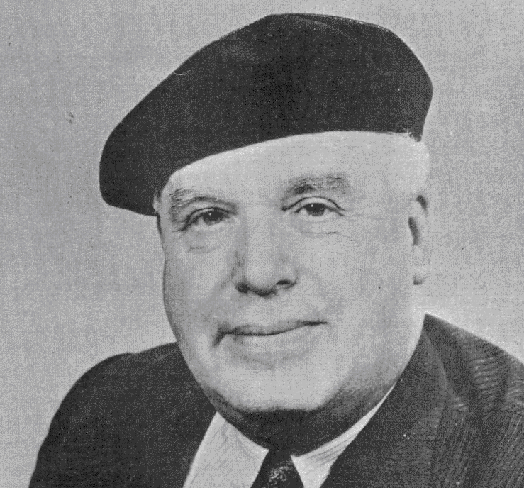
Lewis Leroy
In 1924 the Leroy organisation consisted of two people with a capital of £100. In those days independent holidays abroad were the prerogative of the wealthy but even then the Leroy family was able to arrange reasonably priced inclusive holidays on the continent. The organisation was quick to see that, although some people enjoyed touring, others preferred to reach a sunny location as quickly as possible and spend their holidays basking in the sun.
Lewis Leroy, habitually seen wearing the black beret which he had made his personal trademark, had built over the years before and after the second world war a business with a solid reputation for good value and personal service. By 1962 Leroys was a substantial touring and holiday business, owned a fleet of coaches and now held the controlling interest in an independent airline.
Without detracting anything from Hugh Kennard's vast skill and experience there is no doubt that Audry, an attractive and able business woman, was a strong partner and two comments made during the compilation of this work referred to her as a power behind the throne. Even at Lympne, one recalled, she would be up in the cockpit of a departing aircraft saying: `Shouldn't we be going now?'
Setting up Air Ferry, a brand new airline, was a complicated business. `It was a terrific struggle,' Audry recalled recently: `We were feeling our way.' The setting up or, in some ways as `Flight' indicated, re-opening of the various departments continued through the autumn of 1962. The writer applied to Manston at this time hoping to be involved at an early stage and received a courteous but negative reply; it was to be another seven months before the much sought after vacancy arose.
Air Ferry occupied what, at that time, was all of the area given over to civil use on a roughly rectangular site. This adjoined the large concrete apron, constructed by the U.S.A.F. for their F84s, on which the civil aircraft were parked and manoeuvred for loading and unloading.
A line of buildings faced onto the apron, a fascinating microcosm of airfield architecture as can be found on airfields dating back to the first world war. The line was dominated at one end by the large hangar, constructed in 1918, where Engineering was established; made up of the traditional sections for Airframe, Engines, Instruments, Radio, Tyre Bay, Trimshop and Technical Records. The Refuellers and Aircraft Cleaners also came under the Chief Engineer, the former with their tankers and oilers parked next to the hangar.
There was also a smaller hangar, brought over long ago from Westgate and not used by Air Ferry, the Bonded Store which housed the stocks of duty free goods sold on the aircraft and a more modern brick building for Customs use. This contained the emigration and immigration hall, with the landing officer at one end, through which the passengers filed on their way to and from the aircraft.
Next came a long single storey wooden building, probably R.A.F. built, and utilised for the Silver City trooping flights. It was used at one end as offices for Management, Commercial and Accounts and at the other end by Operations. A small, unpretentious wooden hut, usually equipped with the best piece of carpet on the airfield, was sited out on the apron. This was the domain of the Tarmac staff, responsible for marshalling the aircraft and carrying out the loading and unloading of baggage, bonded goods and catering.
Immediately behind the offices was a staff car park and a nissen hut used by Operations, the Chief Air Hostess and as a uniform store. A service road ran along behind the line of buildings with the second part of Air Ferry's accommodation on the other side of the road.
Opposite the nissen hut were some huts used by Flight Catering and which adjoined the passenger terminal. Originally built in the 1920s as an R.A.F. workshop, the terminal was of brick construction with an unusual, but attractive rounded roof, rather like a very large nissen hut. In the fifties the American Air Force used the building for the overhaul of jet engines from the Thunderjets and Sabres and oil residue in the concrete floor caused recurring difficulties in making carpet tiles stick during the following decade. Now, with its white walls and woodwork painted in `Air Ferry blue', it presented a smart appearance for the coming season. In addition to the departure lounge the terminal accommodated the Traffic section, a small shop, the kitchen and the staff canteen.
Next to the terminal were several WWI wooden huts, into one of which Accounts would be banished during 1964, and then a large open space used as a car park for passengers arriving independently to join their tours.
Manston received some publicity in the local papers, although not all of this was positive as a short article in the 13 July `Isle of Thanet Gazette' was devoted to a complaint about the noise of jet aircraft flying over Ramsgate, which the Ramsgate Hotel, Guest and Boarding Association had addressed to the town council.
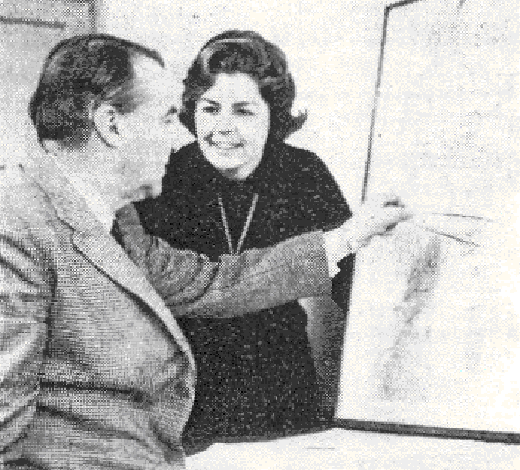
Hugh and Audry Kennard
Air Ferry was the subject of a lead article on 17 August which featured an interview with Wg Cdr Kennard and included details about the formation similar to that published in `Flight'. A further headline article `Day Air Trips to Ostend' in the `Gazette' on 21 September featured another interview with Hugh Kennard who explained that the company was quietly and gradually settling in at Manston. It was anticipated that day trips during the summer season with flights on a regular basis to Ostend and to Le Touquet would have a big appeal for holidaymakers in the area.
The 5 October `Gazette' reported that Minster's ten year footpath war had flared up again with repeated requests for better access from Alland Grange along past the loop hangar entry to the Acol road. Part of the villagers' ire was directed at the bus company whose charge for a necessary, but circuitous, diversion was resented. The following weeks issue featured the marriage of Ingrid Challis, ex-Silver City and now Senior Traffic Assistant for Air Ferry, to John Osborne, a Customs & Excise officer based at Manston.
Air Ferry's applications to the Air Transport Licensing Board for scheduled flights, including day return trips, to Ostend and Le Touquet, were covered in the last news item in the `Gazette' that year. Objections to the applications predictably came from British United, Silver City and also Channel Airways. It was stated on Air Ferry's behalf that the permanent Thanet population of some 85,000 increased with the summer influx to something like 3,500,000 with a consequent demand for day trips.
Preparations continued through the winter of 1962/63, the snow which arrived on Boxing Day heralding the worst conditions since 1947. Snow fell in huge quantities and the sea froze in places around the south coast.
The management at this time comprised Hugh Kennard as Managing Director; Audry Kennard as Traffic Director; Captain W.H.B. Wood, Chief Pilot; R.H. Illsley, Chief Engineer; P. Wannop, Commercial Manager and J.Russell as Traffic Superintendent. T.R. Leigh, the son of Hugh Kennard's Commanding Officer back in 1940, was Chief Accountant. Peter Wannop and Joe Russell were both ex Silver City. Joe was also ex-Royal Navy; he had been injured in the Battle of the River Plate and later in the war was on the Arctic convoys to Russia.
Ron Illsley had been in aviation since 1934 when he began work with the Boulton & Paul Aircraft Company. His career took him to Saunders-Roe, Imperial Airways and Flight Refuelling Ltd. In 1954 he joined Silver City as Engineering Superintendent at Blackbushe and in 1959 was transferred to Manston as Engineering Manager - Silver City Airways.
Flight catering was under the supervision of Jeremy Kennard while the Kitchen and Staff Canteen were run by Gwen Laycock.
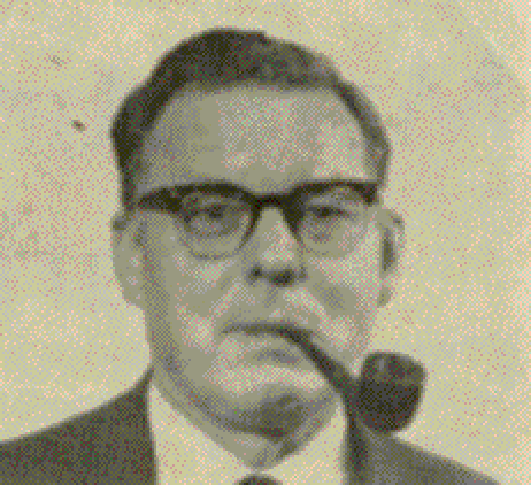
Ron Illsley
By this time suitable aircraft had been located and arrangements were being made for their delivery to Manston. Balair, a subsidaryof the Swiss national airline, Swissair, operated DC-6, DC-4 and Viking aircraft and Air Ferry purchased one DC-4 and their two Vikings which were up for sale. Hugh kept the DC-6s in mind for the future. Starways, based at Liverpool, was one of the DC-4 operators in the U.K., and an aircraft from them was also acquired.
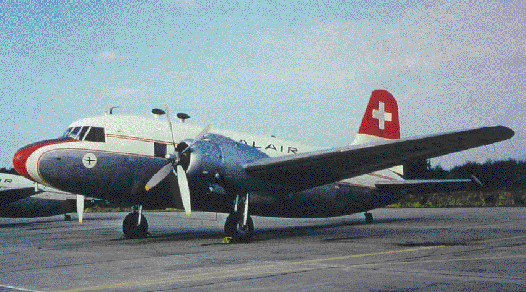
HB-AAN of Balair, later Victor Foxtrot (Eddie Fuller Collection)
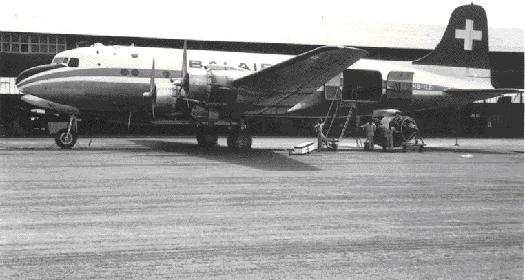
HB-ILC of Balair, later Foxtrot Yankee (Air-Britain)
Captain W.H.B. (Bill) Wood had been appointed Chief Pilot on 1 October 1962 and made a very significant contribution to getting Air Ferry off the ground. He wrote the operations manuals, which proved their worth when in use, and were highly regarded. Another key area was his design work on the DC-4 to enable it to carry 84 passengers - safely. On the ground the aircraft was tail heavy and the first act by the ground crew, as the engines were shutting down, was to place a tail post beneath the rear fuselage, the post being held in place by a pin on a chain.
To carry more passengers it was necessary to move some weight forward and Bill thought out several modifications to achieve this. The water tanks for the toilet and the galley were re-sited from the back of the fuselage to a more forward position, this work naturally included some re-running of the piping, and following these changes the galley box was also re-located further forward. Another modification he required was the re-siting of the oil tank from a flat position amidships to a more forward location and placed on end. When these changes were made they found that they had added 10 knots to the top speed of the DC-4 and the pilots were occasionally asked: `Are you a DC-6?' All this, of course, was in addition to the task of interviewing and engaging pilots in time for the start of operations.
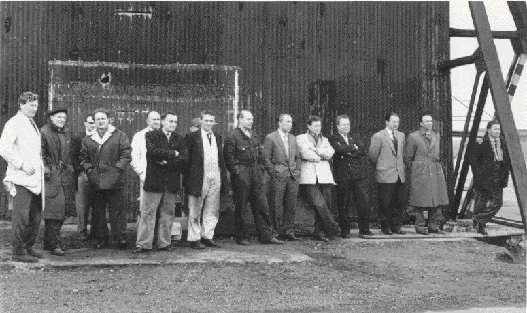
In the beginning….(Ron Blake)
Ron Blake and Tony `Spike' O'Reilly were the first two engineers appointed and their first job was to partition off a section of the great echoing hangar, which could be exceptionally draughty in a Thanet winter, to work in. After R.A.F. service in Hong Kong, Ron had joined Silver City at their formative stage at London Airport when they operated some Lancastrians and two DC-3s. This was long before car ferry operations were thought of and he moved with Silver City to Blackbushe, Lympne, Lydd and finally to Manston. Following Freddie Laker's talk earlier in the year he was one of those who went to B.U.A. at Gatwick when the civil side of Manston closed. Ron would be the inspector in charge of the radio section.
Another ex-Silver City Manston employee starting at this time was Frank Strainge, as Electrical Inspector, and another early joiner was Robbie Thomson as Hangar Foreman. After working for Newcastle Flying Club, Robbie had joined the R.A.F. in February 1940 and, by the Battle of Britain, was working on Hurricanes and Spitfires at two key sector stations, Kenley and Tangmere. He was at North Coates in Lincolnshire when the Beaufighter Strike Wing operated from this exposed coastal airfield and post war, was in Berlin at the time of the famous air lift to the beleaguered city.
An early photograph taken in front of the hangar shows Robbie, Gordon Spires, (? Stores), Len Mees, engines; Reg Hampton, stores; Doug Twyman, tyre bay; Sid Walker, refueller; John Verrion, refueller; Jim Jones, airframe; Eddie Edgar, engines; Don Baigent, technical records; Harry Burgess, Instrument Inspector; Ron, Frank and Spike. Not on the photograph, but an important member of the team, was Ken Barker, a senior man on engines and airframes. Although many of the engineers were ex-R.A.F., Ken came from an aircraft industry background and had once worked up at Wymeswold on DC-3s.
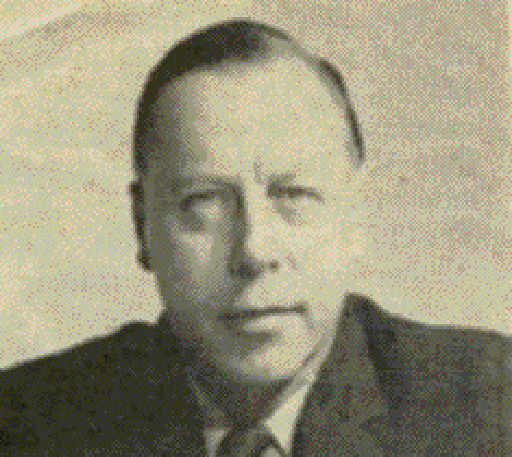
Don Brooker
The Chief Air Hostess was Maureen Pople, usually known as `Pop'. Maureen had started her working life in farming, as a herdswoman, and later worked in a hotel near Maidstone. Occasionally one of the Skyways Coach-Air staff called in, very smart in her uniform, and Maureen decided to make a move into aviation. She eventually gained an interview with Audry Kennard at Lydd. Pop was labouring under a heavy cold and felt ghastly; she had the awful feeling that the interview might be in the balance and stressed to Audry: `I'm very good with animals.' Audry thought this was the funniest thing she had heard for a long time and, for whatever reason, Pop was in.
The air hostesses were required to fly on the air ferries in addition to the charters and later on Maureen flew for two companies out of Gatwick. She recalls those early days fondly; one day, with early enthusiasm, she helped to unload baggage at Basle until the crew pointed out this was not quite the thing; another time on a Palma night flight she found there were only eight sets of plastic cutlery for thirty two passengers. Then there was the hostess who returned from Paris having left the inner, but vital, part of the Elsan over there and whose absence was not noticed by the passengers using the facility, although it was noticed by the horror struck staff back at base; and the very rough flight for one of her colleagues when, after many used sick bags had been piled into the toilet, one passenger urgently required that a search be made for some missing dentures.
Early aircrew appointments, on 1 February 1963, were Captains P.J. Souster, H. Tubman and D. Brooker, followed two weeks later by R. McNay. Captain Stimpson joined at this time, and on 1 March, Captain J Gibson arrived. The First Officers at this stage were W. Steel, from 1 January and, in February, K. Winyard, V. Kellard, D. Laker and D. Hendley; John Hazel and P. Thomas joined on 1 March.
Hugh Tubman had joined the R.A.F. in July 1940, gained his wings in February 1941, and from April of that year was with No. 57 Squadron flying Wellingtons in Bomber Command. By September he had flown on twenty one operations and then had a `rest' at an O.T.U. After a time with No. 115 Squadron he joined 420 (R.C.A.F.) Squadron in January 1943 for more war operations, being awarded the D.F.C. and was Mentioned in Despatches. Post war he remained in the R.A.F., flying Yorks in Transport Command until 1949, when he left the service but continued to fly Yorks, although now for Skyways. He also flew Constellations and DC-3s with Skyways before joining Silver City at Lydd, again with DC-3s and also the Bristol Freighters.
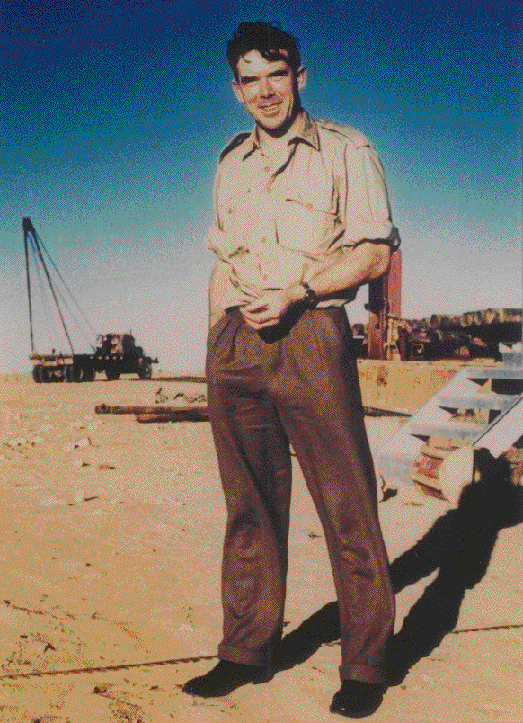
Hugh Tubman (Rosemary Wood)
Audry and Maureen Pople spent much time writing the cabin attendants' manual, a comprehensive list of procedures which, when finished, filled a thick binder and had a serviceable cover in `Air Ferry' blue. There were also safety leaflets to organise and life jacket instructions, Maureen being the model used for the latter. Then they turned their attention to advertising for hostesses and going through the initial selection process for interviews. After that Pop was busy working up her establishment of hostesses and arranging training, survival exercises and, most important, the provision of well tailored uniforms. The air and ground crew uniforms were standard navy blue although the hostesses' headwear was a fetching, new style bowler; this and the AF winged crest used as the company logo were designed by Audry.
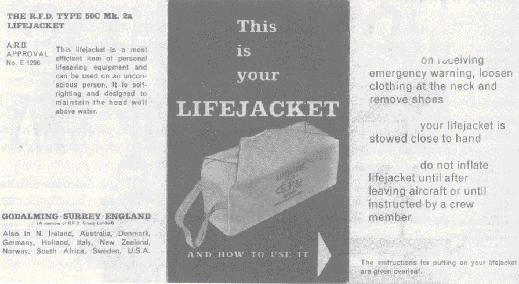
Safety Leaflet
Even at this stage Hugh Kennard was alert for new opportunities. About this time serious consideration was given to acquiring the civil side of Manston to reduce the dependency of the civilian operations on military requirements. The Ministry, however, was not receptive to these overtures.
Meanwhile, the aerial activity had already started.
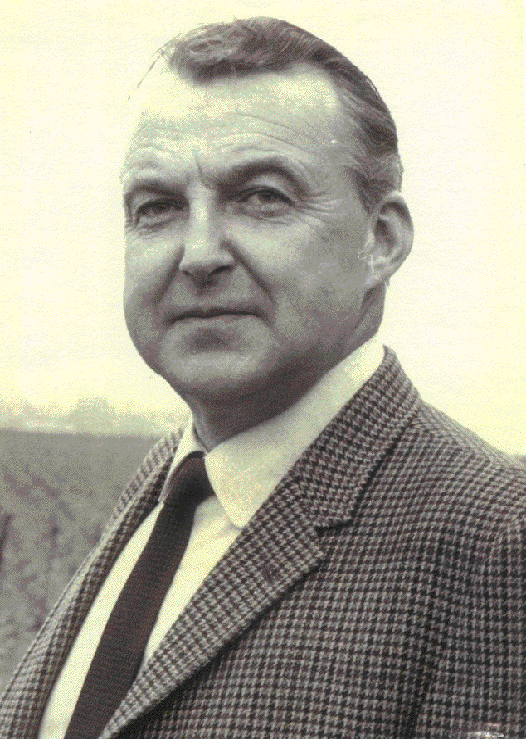
Hugh Kennard (Jane Kennard)